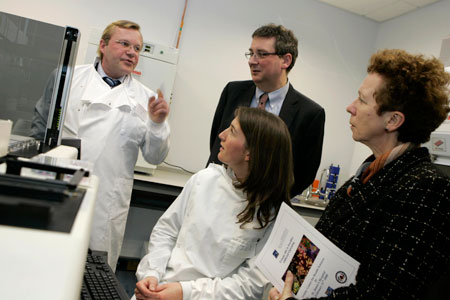New €2m Imaging and Screening Facility to Improve Disease Diagnosis and Treatment Launched at TCD
Posted on: 12 February 2008
High Content Analysis Facility Launched at TCD Institute of Molecular Medicine
A new €2 million imaging and screening facility, providing extremely advanced imaging of human cells that will improve patient care and accelerate drug discovery in cancer and inflammatory diseases was launched on 11 February last at Trinity College’s Institute of Molecular Medicine (IMM) at St James’s Hospital. The High Content Analysis Facility, the first of its kind among European academic institutions, has the capacity of generating hundreds of times more scientific information which will result in radical improvements in the diagnosis and treatment of disease.
Commenting on the significance of the facility, Dr Yuri Volkov, Senior Lecturer in Molecular Medicine at Trinity’s IMM said:”High Content Imaging technologies have become indispensable tools in the advancement of our understanding of how the human body works at the cellular level. The scale and speed of this technology is unmatched by conventional analytical tools. It has the capacity of providing up to several hundred items of scientific data from the one cell sample and can potentially increase the speed of diagnostic tests by 100-200 times for patients”.
The High Content Analysis Facility focuses on how the human genome functions and its role in disease. A major area of research currently being carried out at the Trinity IMM with the aid of this new technology is how cancer will respond to prospective therapies by assessing the functions of each individual gene in the human genome, in a process called gene silencing (siRNA). Lung, gut and prostate cancer as well as heart disease are currently key areas of research at the Institute of Molecular Medicine, utilising the High Content technologies. Other major areas of research include infection and immunity and inflammatory diseases. Using the High Content approach, Trinity’s IMM scientists recently made the groundbreaking discovery concerning the way in which hepatitis C virus escapes the immune defence.
Trinity’s Institute of Molecular Medicine is also a leader in the area of Nano-Medicine. With the aid of the High Content Analysis facility, the ‘nano-drugs’ of the future are already being developed, screened and analysed in the centre today.
“Nano-materials, tiny objects, often smaller in size than viruses and even single protein molecules, have a capacity to penetrate through the tissues and cell membranes of the human body reaching the nucleus, or ‘heart of the cell’- in a matter of minutes. Such properties of nano-materials can be exploited to generate a new class of nano-tools for a very rapid and targeted medicinal drug delivery”, explained Trinity’s Dr Yuri Volkov, and academic leader in Nano-Medicine.
“High Content Analysis methods enable us to quickly locate the nano-particles in several cell types at a time and to monitor each individual cell responses to the prospective ‘nano-bullets'”, added Dr Volkov.
Over 30 research projects involving over 40 researchers at the Institute of Molecular Medicine are currently utilising High Content Analysis technologies. The facility also plays a central role in national and international collaborative scientific research projects.
“This state-of-the-art facility has been set up to foster the development of the Irish biomedical research community and to provide new dimensions in education and expertise for scientists both nationally and internationally”, stated Professor Dermot Kelleher, Head of the TCD School of Medicine and IMM on the occasion of the launch of the new High Content Analysis Facility.
“The success of this facility, which is considered to be an international centre of excellence, has been underpinned by the efforts of the multi-disciplinary team of scientists whose primary research goal is to translate the fundamental results achieved through the advancement of these technologies into better patient care in the future,” concluded Professor Kelleher.
The world’s first academic course in High Content Screening and Analysis is also being conducted at Trinity’s Institute of Molecular Medicine where approximately 30 postgraduate students from a range of scientific and medical disciplines receive the very latest theoretical and practical training from a host of world leading experts from industry and academia. The first cohort of students have completed the postgraduate course.
The state-of-the-art facility has cost in excess of €2 million. Funding was received from the Health Research Board of Ireland, Higher Education Authority (PRTLI Cycle 3) and the Trinity Foundation. Major international High Content Analysis technology developers, such as Thermo Fisher Scientific and GE Healthcare, also substantially contributed to the establishment of the facility.
The new facility was launched by Dr Ruth Barrington, CEO of the Dublin Molecular Medicine Centre.

